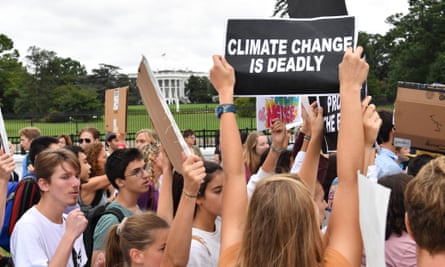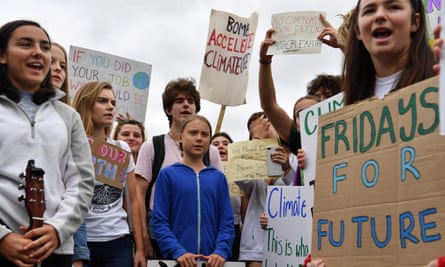Swedish climate activist Greta Thunberg – who has inspired young people around the world to strike in protest of inadequate government action on the crisis – accompanied her American counterparts in the youth climate movement at a rally near Donald Trump’s White House on Friday.
Thunberg quietly joined near the edge of the group, whispering along with chants and shaking her head when thanked by other advocates.
The protesters were so surrounded by reporters and TV cameras that they had difficulty beginning a planned march toward the White House. Thunberg fell back in the crowd. “We love you, Greta,” fans yelled.
Trump, who has repeatedly denied climate science, has opposed major US efforts to stem greenhouse gases from fossil fuels that are heating the globe, as well as rolling back or attempting to dilute other environmental protections related to air and water quality and wildlife protection.

He recently feuded with his own government scientists about the expected path of a the deadly Hurricane Dorian that hit the Bahamas catastrophically before grazing the US east coast last week, with the president appearing in front of a map at the White House altered by a permanent marker.
“No more Sharpies, lies and censorship,” one protest sign read.
Most other nations are off track to meet the goals needed to keep temperatures from rising to dangerous levels. They are already 1C higher than before industrialization.
The gathering of a few hundred preteens, teenagers and their supporters chanted: “Protect our future.”

On Wednesday, Thunberg will testify before the US Congress and then join young Americans who are suing the government over the crisis, speaking from the steps of the US supreme court.
Thunberg, who sailed to the US last month instead of flying, will participate in a global strike next Friday. It is partly inspired by her decision to spend Fridays protesting outside the Swedish parliament, a campaign that has become known as Fridays for Future.
The annual UN general assembly will meet in New York to discuss the climate crisis later this month, and activists will target the global fossil fuel chief executives’ conference taking place in the city the same day.
Thunberg briefly took the megaphone at the gathering, to enthusiastic cheers. She had seemed to deliberately keep to the fringes of the event, chanting rather shyly.
She said she wouldn’t give a speech because previous speakers “have already said everything”.
But she added: “I just want to say I’m so incredibly grateful for every single one of you, I’m so proud of you, who have come here and I, it’s a lot of people … this is overwhelming. Just never give up, we will continue and see you next week on 20 September” - for the planned global climate strike.
There appeared to be several hundred people at the event.
“We’re striking today to save tomorrow, not to save life in 50 years but to save tomorrow,” said Nadia Nazar, a 17-year-old organizer with the youth group Zero Hour.
The world’s leading climate scientists warned last year that humanity only has until 2030 for global heating to be kept to a maximum of 1.5C, beyond which even half a degree will significantly worsen the risks of drought, floods, extreme heat and poverty for hundreds of millions of people.
